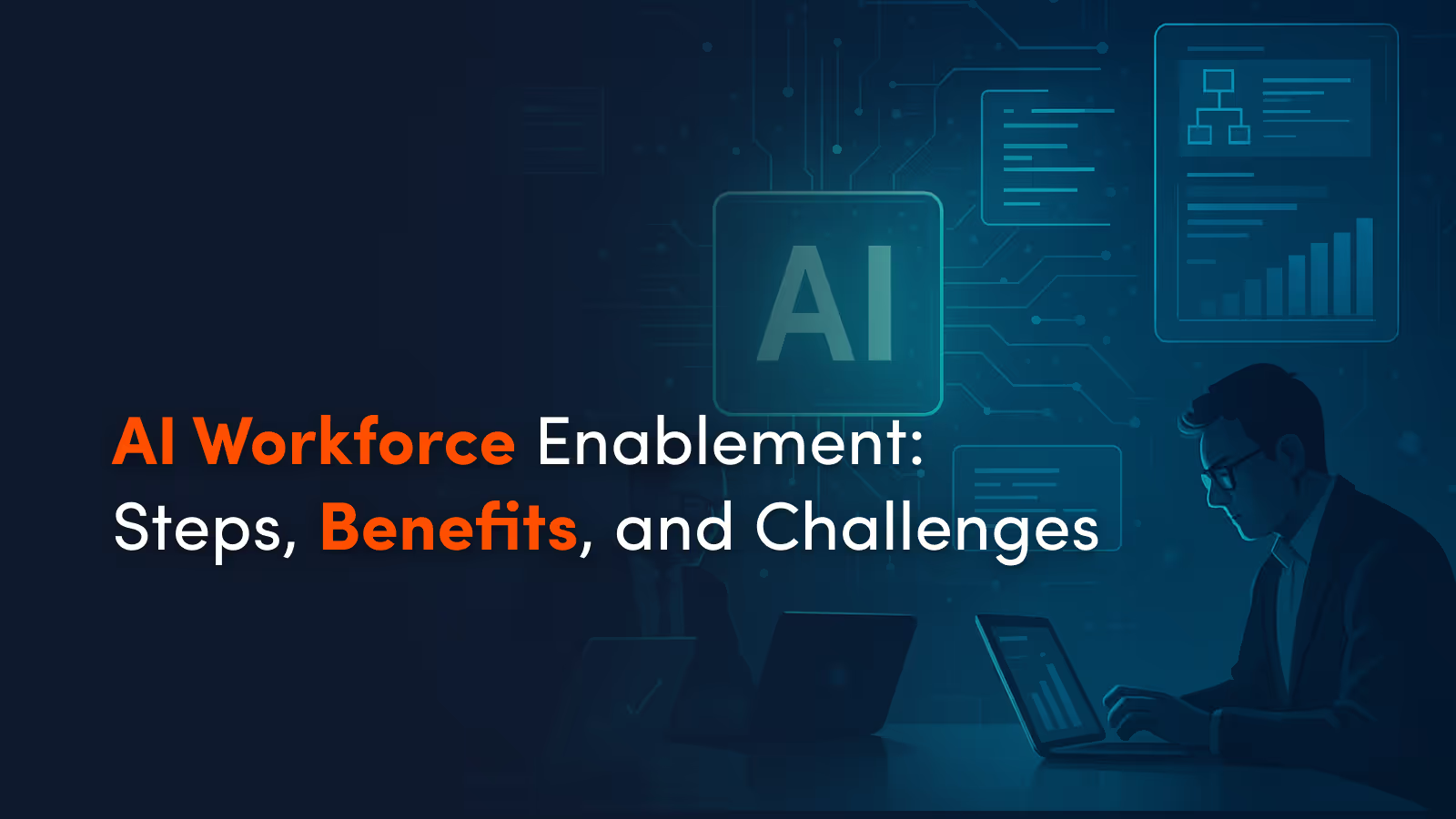About the Blog
Key Takeaways
- AI workforce enablement empowers faculty, staff, and students to leverage AI tools, improving efficiency and engagement across higher education institutions.
- Colleges embracing AI adoption in higher ed gain a competitive edge through streamlined operations, innovative teaching methods, and data-informed decision-making.
- A successful AI workforce strategy starts with alignment between tech capabilities and institutional goals, pilot programs, and scalable training initiatives.
- While ethical considerations and resource limitations pose challenges, proactive planning helps universities lead rather than lag in the higher education digital transformation.
What Is AI Workforce Enablement Really About?
AI workforce enablement refers to preparing and empowering individuals—faculty, staff, and students—to confidently use and collaborate with AI tools in their academic and professional environments. In the context of higher education, this doesn't just mean offering AI courses. It means integrating AI into the very workflows, teaching models, and administrative operations that power the institution.
At its core, AI workforce enablement is about equipping every layer of the campus ecosystem to use AI responsibly and effectively. This includes training admissions teams to use predictive analytics, helping faculty co-create course content with AI assistance, or enabling student services staff to deploy AI chatbots that provide 24/7 support. The goal is to foster a campus culture where AI is seen not as a threat, but as an enhancer of human potential.
Real-world examples are already emerging. Consider institutions like Arizona State University and Georgia State, which are leveraging AI-driven advisors to provide scalable, personalized support. Or think of how AI is being used in course design—tools like ChatGPT or other content generators help faculty build more engaging, adaptive learning experiences. These aren’t hypothetical; they are proof points that AI workforce enablement is not a futuristic concept—it’s already happening.
Why Enabling an AI Workforce Is No Longer Optional
Higher ed is under pressure. Institutions must navigate shrinking budgets, rising student expectations, and an ever-accelerating pace of technological evolution. In this context, AI workforce enablement isn’t a “nice to have.” It’s mission-critical. Colleges and universities that resist or delay this shift risk falling behind in relevance, outcomes, and reputation.
Research supports this urgency. According to a 2024 Educause study, nearly 60% of higher ed leaders say AI will “significantly impact institutional strategy” in the next two years. Yet, fewer than half have a defined plan for AI adoption in higher ed. This gap reveals a massive opportunity for forward-thinking institutions to lead the way.
Early adopters of AI workforce strategies are already seeing benefits: streamlined administrative processes, improved student support systems, and more dynamic learning environments. These schools are not replacing staff with AI—they’re turning staff into AI collaborators. In doing so, they’re reimagining what academic and operational efficiency and engagement can truly look like.
Steps to Kickstart Your AI Workforce Enablement Journey
Before diving into tools or tech, colleges need a roadmap. AI workforce enablement isn’t just a tech initiative—it’s a strategic one. That means engaging leadership, understanding workforce needs, and building a long-term plan that aligns with the institution’s mission.
Step 1: Assess faculty and staff readiness
Surveys and interviews help gauge current knowledge, comfort levels, and enthusiasm around AI tools. This diagnostic step highlights areas where support or upskilling is most needed, ensuring that your plan starts with people, not platforms. It also allows leadership to identify early adopters who can serve as AI champions across departments.
Step 2: Align AI with institutional goals
AI should enhance—not distract from—core academic and operational missions. Whether your institution is focused on increasing retention, boosting operational efficiency, or modernizing instruction, AI tools should be mapped directly to those goals. Strategic alignment ensures that AI is used purposefully rather than haphazardly.
Step 3: Start with pilot programs
Small, contained pilots—such as introducing AI grading assistants in large gen-ed courses or using AI-powered chatbots for admissions FAQs—allow institutions to test use cases, gather feedback, and demonstrate value. These early wins can build momentum and buy-in across campus communities.
Step 4: Invest in scalable learning programs
Workforce enablement hinges on learning. That means offering workshops, micro-credentials, and on-demand training for staff and faculty. Institutions should also consider forming AI learning communities or partnerships with edtech providers to ensure access to current tools and training resources.
Step 5: Measure outcomes and refine strategies
Like any transformation initiative, AI workforce enablement should be tied to measurable KPIs. These might include improvements in student engagement, reduced administrative workload, or faster response times from student services. Continual assessment ensures that initiatives stay aligned with impact.
Benefits and Challenges of AI Workforce Enablement
Benefits:
AI workforce enablement brings measurable gains to both academic and operational areas of a college or university. It helps institutions scale personalized student support, automate repetitive administrative tasks, and enhance decision-making with real-time data. The result? More empowered staff, more engaged students, and better institutional performance.
This enablement also promotes innovation in teaching and learning. AI tools can provide faculty with new ways to design assessments, generate feedback, or even personalize instruction. By integrating AI across the campus, schools are fostering a culture of creativity and future-readiness. And let’s not forget the appeal to prospective students—tech-forward campuses are increasingly attractive to digital-native learners.
Moreover, by evolving staff roles from "assistants to workforce" to "collaborators with AI," institutions ensure long-term workforce adaptability. They’re not just reacting to the AI wave—they’re shaping the future of academic work.
Challenges:
Of course, this transition isn’t without hurdles. One major concern is ethical considerations—how do we ensure AI tools are used responsibly, without bias, and with transparency? Institutions must proactively create policies around AI use, privacy, and academic integrity to build trust with stakeholders.
Another challenge is workforce anxiety. There are real fears around job displacement or loss of academic autonomy. Higher ed leaders must communicate clearly that AI is a partner, not a replacement. Change management strategies—such as listening sessions and peer-led training—can help ease this shift.
Finally, many institutions face resource constraints. Implementing a campus-wide AI strategy takes time, funding, and leadership commitment. But by starting small and scaling intentionally, even resource-limited schools can find a path forward.
The Future of Workforce Enablement in an AI-Driven World
The next five to ten years will redefine work in higher education. Administrative and academic roles will increasingly integrate AI, with staff expected to use tools that automate scheduling, reporting, advising, and communication. This means that future-ready professionals will need both technical fluency and ethical literacy.
Expect to see more AI-integrated curricula, where students learn alongside AI, using tools in real-time projects or simulations. AI won’t be a separate subject—it’ll be infused into business courses, biology labs, and beyond. Similarly, we’ll see AI deeply embedded in campus infrastructure, from admissions decision models to financial aid optimization systems.
Ultimately, the institutions that lead this transformation will not just survive the tech wave—they’ll thrive in it. By prioritizing AI workforce enablement now, colleges ensure they’re prepared for tomorrow’s students, staff, and systems.
Conclusion
AI workforce enablement is no longer a “future of work” buzzword—it’s the present reality for higher ed. Schools that act now stand to gain in agility, performance, and relevance. From increasing staff productivity to improving student outcomes, the potential is too big to ignore.
The path forward won’t be identical for every institution, but the first step is the same: start building awareness, training programs, and strategic alignment today. Waiting until AI is fully embedded across the industry is too late. Leading institutions are already laying the foundation—will yours be next?
Frequently Asked Questions
What is the difference between AI and AI-enabled?
AI refers to the technology itself, while AI-enabled means that people or systems are empowered to work with and benefit from AI tools.
How long does it take to implement an AI workforce enablement strategy?
It varies, but initial steps like readiness assessments and pilot programs can begin within 3–6 months, with full implementation often taking 12–24 months.
What are some examples of AI workforce enablement in higher education?
Examples include using AI chatbots for admissions, AI-assisted course design by faculty, and predictive analytics for improving student retention.










